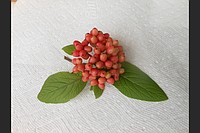Q I just returned from a trip to St. Louis. All down the sides of a residential street there were shrubs/trees/bushes (?) with what appeared at first glance to be red apples all over them. Upon closer inspection, I discovered it was clusters of red berries ... these shrubs were dense with foliage, the leaves being somewhat rough/scratchy. No one knew the name. I have included a photo of the berry cluster. Thank you.
A The plant is a viburnum. I believe it is the non-native Viburnum lantana, commonly called Wayfaring tree. It doesn't take the heat and humidity of the South well, so you don't see it in our landscapes. It is common in the Midwest. It has a tendency to sucker and grow beyond its plantings. Some states label it semi-invasive.
■ ■ ■
Q Last year I had good broccoli, cauliflower and brussels sprouts in my fall garden. The caterpillars weren't as bad. I bought transplants last fall, but this year I want to use seeds. Do I need to start them for transplants or just plant them in the ground? How soon do I plant them? The package directions are for spring planting, six to eight weeks before last frost, but it also says a soil temperature of 70-75 degrees. I had so much trouble getting my squash seeds to germinate this spring because the ground was too cold that now I worry that the soil temperature in August will be too high, but it seems wrong to start seeds in the air conditioning.
A Mid-August is when we typically can begin planting the cool-season vegetables. Transplants are most common for the cole crops you mentioned, but you could direct-sow the seeds in the ground. I would start them now. With the higher temperatures, they will germinate quickly. Water will be critical to get them established, but it can be done. It will delay your harvest by six to eight weeks, but with season extenders, many gardeners are growing year-round anyway.
Photo Gallery
In the Garden — July 31, 2021
Photographs intended to accompany Janet Carson's "In the Garden" column published July 31, 2021.
[Photos not displaying? See arkansasonline.com/731carson]
Q We are having problems with nimblewill. It has more or less taken over a very large area that has been overseeded the past two years with fescue and bluegrass. Our front yard is all zoysia and there are small selected areas that nimblewill is showing up. So far, I've been able to control it by pulling the nimblewill out of the small areas. Does pulling it get rid of the plant permanently? Is there anything that can be applied that won't kill St. Augustine, fescue/bluegrass or zoysia?
A Nimblewill is a grassy perennial weed that tends to grow better in the shade. This makes it more aggressive with many of our lawn grasses, which struggle in the shade. Zoysia gets thinner the more shade it gets. St. Augustine is probably the best alternative for a shade lawn, but in deep shade it too can struggle. Bluegrass is not tolerant of our hot, humid summers and often thins out by midsummer, and fescue can do the same. When a lawn grass grows thin, conditions are more conducive to lawn weeds taking over. A thick, dense turf is often the best defense. If you have lots of shade, consider using a ground cover instead of grass. I always thought we should have worked on making nimblewill a shade-tolerant turfgrass species, but it isn't vigorous enough. You may disagree. Pre-emergents won't work, since it is perennial. Spot treatments of Roundup would get the nimblewill but would also kill your desirable grasses. Pulling it up roots and all should eradicate it. But if there isn't a solid covering of lawn, other weeds will come in.
■ ■ ■
Q I bought these Arkansas Diamonds coleus plants early this spring because of a column you wrote for the Arkansas Democrat-Gazette about the Arkansas Diamonds plants. As you can see, they have performed well and brought me great delight.
A Glad you are enjoying them. I think this Flame Thrower series of coleus is a winner as well. I also bought one of the combo pots with three varieties -- Flame Thrower Sriracha, Habanero and Serrano -- and they are thriving. My Honeybell cuphea is a showstopper as well, and the hummingbirds love it! Thanks for sharing.
Retired after 38 years with the University of Arkansas Cooperative Extension Service, Janet Carson ranks among Arkansas' best known horticulture experts. Her blog is at arkansasonline.com/planitjanet. Write to her at P.O. Box 2221, Little Rock, AR 72203 or email jcarson@arkansasonline.com

